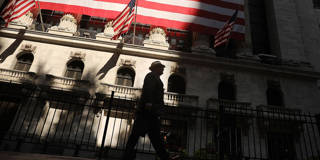OnPoint Subscriber Exclusive
Longer Reads provide in-depth analysis of the ideas and forces shaping politics, economics, international affairs, and more.

The Brutes’ New Suits
Today's leading financial observers, from left to right, depict a banking sector teeming with bespoke-suited knaves willing to mortgage their mothers’ souls. As several recent books make clear, violation of rules has become deeply integrated into banks' business models.
NEW YORK – In January 2023, I interviewed the Financial Times columnist Martin Wolf, hoping the conversation would flesh out the review I was writing of his recent book, The Crisis of Democratic Capitalism. Toward the end of our conversation, I asked him to comment on Mervyn King’s book, The End of Alchemy, which I reviewed when it appeared in 2016. King had recently retired as the head of the Bank of England, and Wolf was then at the peak of his influence. They had known each other since their student days, and I wondered about their different paths to authoritative positions within or astride the global financial system.